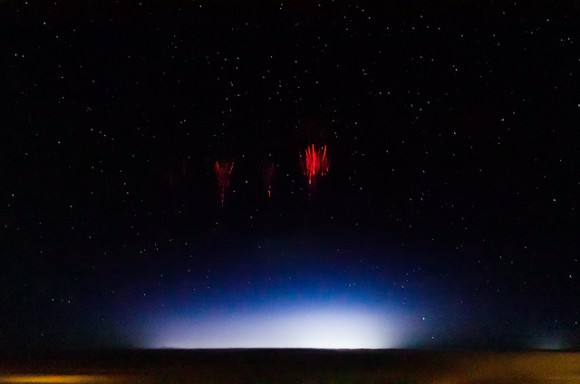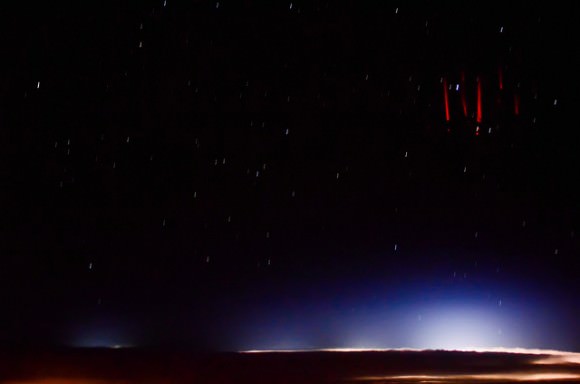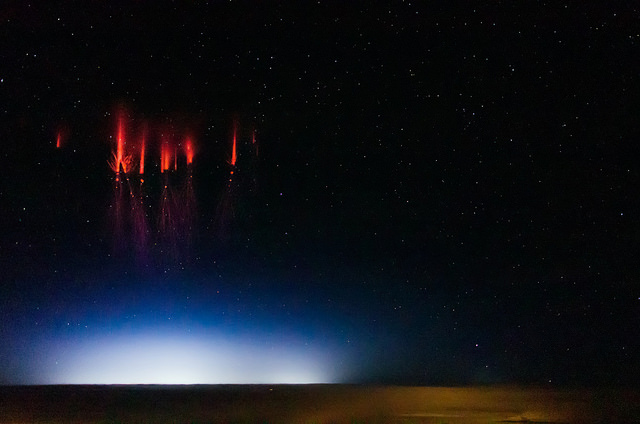When we first checked in with graduate student and astrophotographer Jason Ahrns earlier this month, he had the chance to be part of an observing campaign to try and photograph red sprite lightning from the air. Using a special airplane from the National Center for Atmospheric Research’s Aircraft Facility in Boulder, Colorado, Jason was part of a team that used high-speed video cameras and digital still cameras to learn more about this mysterious lightning. They flew over the central part of the US, such as over Colorado, Nebraska, and Oklahoma.
Named for the mythological sprites, which were known for being elusive, this lightning flashes quickly at high altitudes of 65-75 km (40-45 miles), but often as high as 90 km (55 miles) into the atmosphere. They are difficult to see from the ground, thus this airborne observing campaign.
Here are more images and video (some at 10,000 frames per second!) taken by Jason and his team:

Jason said on his blog, documenting the observing campaign, that “Most of what we saw were C-sprites, short for ‘Column sprites’ or ‘Columnar sprites’ – it just refers to their shape as tall, single columns.”
Sprites appear as luminous reddish-orange flashes, and sometimes look like jellyfish with “legs” that reach down into the clouds. Besides the columnar shapes, they also can be shaped like carrots and crowns, but why they take different shapes is unknown. They are thought to be triggered by the discharges of positive lightning between an underlying thundercloud and the ground. They were discovered by accident in 1989 when a researcher studying stars was calibrating a camera pointed at the distant atmosphere where sprites occur.

Above is an image, and below is the video of the same sprite slowed down by about 500 times:
See more information and images/videos on Jason’s Flickr page and his website.


looks more like flares than sprites,they burst then float
Amazing photos! Thank you!
Awesome! TLEs are pretty amazing. I got to see several Blue Jets emanating from thunderstorms (remnants of tropical cyclone Dorian) offshore a few weeks ago. Spectacular!
From piece stumbled across , I have wondered if these elusive, crimson-hued Sprites, flashing ephemerally in the “Mesosphere” over thunderclouds, may have an electrically-charged connection, and/or magnetically-influenced association with the 100 km “metal layers” in the upper Atmosphere ( within greater, Globe-enveloping Magnetosphere ), created by the “intense showers” and “constant rain” of meteoroids. Perhaps there is also a relationship with the conical Blue Jets, that mysteriously ascend from the tops of illuminated thunder clouds.
A Crucial Space Weather Effect: Meteors and Meteoroids ________________________________________
“Meteor physics is important to a broad range of disciplines. Meteors affect upper atmospheric and ionospheric physics and chemistry because meteoric material seeds the upper atmosphere with metallic atoms, ions, and dust…. These particles affect conductivities, create metal layers near 100 km altitude, and provide the condensation nuclei for noctilucent clouds [von Zahn, 2002]. Klekociuk et al., and subsequent press releases have recently suggested that meteoritic dust effects cloud formation and may influence weather, and large dust clouds from bollide explosion may [ affect the Weather Engine ].” _______________________________________________________________________________________
http://www8.nationalacademies.org/SSBSurvey/DetailFileDisplay.aspx?id=691&parm_type=HDS